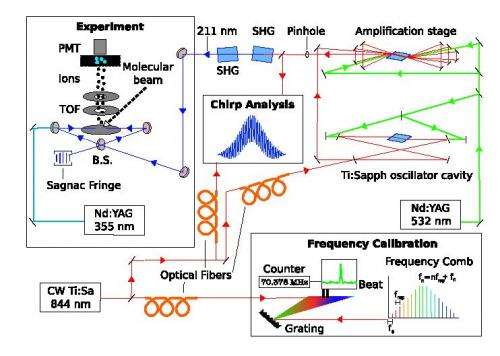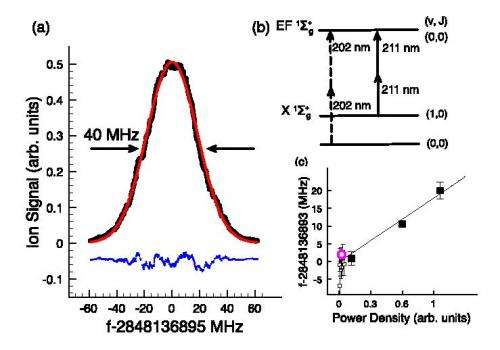June 4, 2013 feature
May the force be with us? Precise measurements test quantum electrodynamics, constrain possible fifth fundamental force

(Phys.org) —Quantum electrodynamics (QED) – the relativistic quantum field theory of electrodynamics – describes how light and matter interact – achieves full agreement between quantum mechanics and special relativity. (QED can also be described as a perturbation theory of the electromagnetic quantum vacuum.) QED solves the problem of infinities associated with charged pointlike particles and, perhaps more importantly, includes the effects of spontaneous particle-antiparticle generation from the vacuum. Recently, scientists at VU University, The Netherlands, published two papers in quick succession that, respectively, tested QED to extreme precision by comparing values for the electromagnetic coupling constant1, and applied these measurements to obtain accurate results from frequency measurements on neutral hydrogen molecules that can be interpreted in terms of constraints on possible fifth-force interactions beyond the Standard Model of physics2. In addition, the researchers point out that while the Standard Model explains physical phenomena observed at the microscopic scale, so-called dark matter and dark energy at the cosmological scale are considered as unsolved problems that hints at physics beyond the Standard Model.
Prof. Wim Ubachs discussed the research he and his colleagues (at University of San Carlos, Philippines; Mickiewicz University, Poland; and University of Warsaw, Poland) undertook, citing some of the challenges they faced, in a conversation with Phys.org. "The challenges in testing QED to extreme precision by comparing values for the electromagnetic coupling constant are twofold," Ubachs says. "Using lasers, we measured transition frequencies as accurately as possible. These measurements, in turn, had to be compared with calculations, which also had to be performed at the highest accuracy levels, involving many steps: First, solving the Schrodinger equation for the H2 molecule, and secondly calculating the relativistic corrections and the terms associated with quantum electrodynamics." The latter, he notes, involves calculating the interaction of the particles with the quantum vacuum – that is, with the spontaneously generated particles from the void.
In the QED calculations, the scientists used the existing best value from CODATA – the physics data base where all previous experiments are evaluated – for the fine structure constant known as alpha. "The value of alpha," Ubachs explains, "is itself derived from two experiments measuring the g-factor of the electron, and alternative recoil measurements on rubidium atoms3." The first value is in principle the most accurate, he adds, bur in order to get from the g-factor to alpha, an enormously complex calculation has to be performed.

Ubachs adds that the HD+ molecular ion is a good testing ground for QED as well, since its single electron simplifies the calculation. Moreover, he notes that since collisions have a disturbing effect on the molecules and perturb the level structure, they performed the measurements in a collisionless molecular beam to determine the fundamental ground tone vibration of H2, HD, and D2. They also derived rotationless vibrational splitting from the combination difference between electronic excitation
"We performed an experiment on the purely vibrating molecules, H2, D2 and HD, because it simplifies the calculations" Ubachs adds. "Experimentally we could also include rotation of the molecule – and in fact we have performed these measurements, which will be published soon – but the calculations are even more complex, and therefore less accurate."
One other challenge also provided their biggest breakthrough – namely, performing the experiment with a long-pulse injection-seeded oscillator-amplifier titanium-sapphire, or Ti:Sa, laser system. "Yes, this is special," says Ubachs. "We developed a special laser system for these types of measurements." The pulses of the Ti:Sa laser are long (≥20 nanoseconds) so that the bandwidth can be narrow, which is determined by the Fourier principle dictating that short-pulsed wave phenomena give bandwidth. "On the other hand," Ubachs continues, "the radiation must be pulsed because we need to produce the fourth harmonic of the fundamental frequency, thus converting the wavelength from 840 nm to 210 nm – something that can only be done with pulsed laser radiation. (Ubachs notes that this special laser will be produced under license by the German company Radiant Dyes.)
![(a) Current and previously measured values for the fundamental ground tone vibration in H2. The dashed horizontal line represents the value [and the shaded (yellow) area represents ±1σ uncertainties] from the full ab initio calculations including QED effects. (b), (c) represent measured values for the ground tone of HD and D2, respectively, along with the full ab initio calculations. These are compared with the results of Rich et al. and McKellar and Oka for HD and D2, respectively. Reproduced with permission from G. D. Dickenson et al, Phys. Rev. Lett. 110, 193601 (2013) May the force be with us? Precise measurements test quantum electrodynamics, constrain possible fifth fundamental force](https://scx1.b-cdn.net/csz/news/800a/2013/ubachsfig3.jpg)
In addition to the Ti:Sa laser, Ubachs points out that two other techniques that the scientists used to address these challenges:
- an additional laser system known as a frequency comb laser for the calibration of frequencies
- the breakthrough in quantum chemistry computational techniques by his colleagues in Poland
Regarding recent disagreement on proton size between muonic hydrogen and atomic hydrogen experiments, when asked if the high level of agreement between the most accurate theory and experiment for the molecular hydrogen level energies may be interpreted to constrain effects of possible long-range hadron-hadron interactions, Ubachs stresses that their work "does not have an immediate impact on the proton size puzzle," adding that the spectroscopy of the hydrogen atom and the muonic atom probes the forces between leptons (electrons and muons) and hadrons (protons). "We're now performing a highly accurate experiment on a system that is calculable and which contains interactions between hadrons. This force is purely electromagnetic in QED, but we test if there are additional contributions that could possibly indicate a fifth force. That being said, our work shows that those are not present, up to a certain level of accuracy."
Going forward, Ubachs sees a number of possibilities for improvement, including extending the pulse length somewhat, which he acknowledges will only give an incremental improvement; probing higher vibrations than only the fundamental ground tone; and taking a drastically different route in performing direct frequency comb spectroscopy on the H2 system along the lines we explored in an atom4.
Ubachs also mentions other areas of research that might benefit from their research. "Other laser spectroscopists will use our Ti:Sa laser that will be marketed by the German company," Ubachs concludes. "We have understood that there is an interest from several scientific groups, in particular in the area of atmospheric physics."
More information:
1Fundamental Vibration of Molecular Hydrogen, Physical Review Letters 110, 193601 (2013), doi:10.1103/PhysRevLett.110.193601
2Bounds on fifth forces from precision measurements on molecules, arXiv.org, submitted 24 Apr 2013, arXiv:1304.6560v1
Related
3New Determination of the Fine Structure Constant and Test of the Quantum Electrodynamics, Physical Review Letters 106, 080801 (2011), doi:10.1103/PhysRevLett.106.080801
4Deep-Ultraviolet Quantum Interference Metrology with Ultrashort Laser Pulses, Science 21 January 2005: Vol. 307 no. 5708 pp. 400-403, doi:10.1126/science.1106612
Journal information: Physical Review Letters , Science
© 2013 Phys.org. All rights reserved.




















